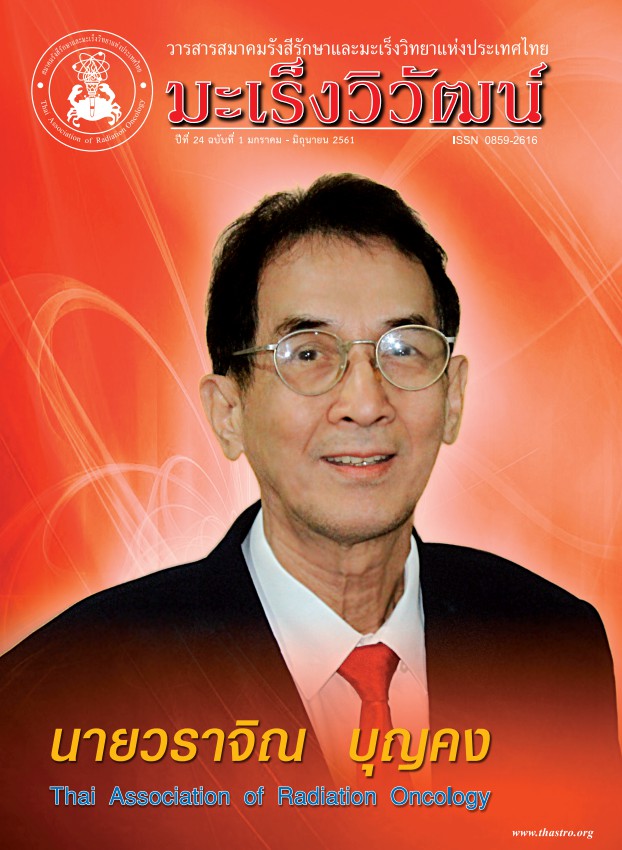The Dosimetric Comparison of Planning Target Volume between Helical Tomotherapy and Volumetric Modulated Arc Therapy in Lung Cancer
Keywords:
Helical tomotherapy, Volumetric modulated arc therapy, Lung cancer, Homogeneity index, Target coverageAbstract
Backgrounds: Radiotherapy is an essential component in lung cancer treatment. Locally advanced lung cancer always presents with large tumor size and needs advanced technique in radiotherapy planning. Helical tomotherapy (HT) and volumetric modulated arc therapy (VMAT) are advanced techniques of delivering intensity-modulated radiotherapy which high dose to target and low dose for organs at risk (OARs) are expected. Objectives: To compare the planning target volume (PTV) dosimetric result between HT and VMAT treatment planning for advanced lung cancer. Material and methods: 4D CT simulation was used for seven lung cancer HT and VMAT treatment plannings. The PTV prescription dose was 6 MV photon, 60 Gy in 30 fractions. The HT and VMAT plans were generated using VoLO™ V.5.0.1.24 and Monaco V.5.11 treatment planning respectively. The dose constraints for PTV was reviewed using ICRU 83 recommendation. The homogeneity index (HI) and target coverage (TC) were absoluted to evaluate the quality of the plan. Results: There was no statistical difference between HT and VMAT PTV dose. The means HI in HT and VMAT techniques were 9.32 and 9.88, respectively (p = 0.313). VMAT had statistically significant better in TC with the mean TC of HT and VMAT of 0.61 and 0.86, respectively (p < 0.001). Conclusions: According to ICRU Report 83, this study shows that HT and VMAT provide similar quality of PTV dose for advanced lung cancer. However, VMAT shows superior in mean TC.
References
สถาบันมะเร็งแห่งชาติ กรมการแพทย์ กระทรวงสาธารณสุข. แนวทางการตรวจวินิจฉัยและรักษาโรคมะเร็งปอด. พิมพ์ครั้งที่ 2. กรุงเทพฯ:บริษัท โฆสิตการพิมพ์ จำกัด; 2552.
Mackie TR, Balog J, Ruchala K, Shepard D, Aldridge S, Fitchard E, et al. Tomotherapy. Semin Radiat Oncol 1999;9:108-17.
Kannarunimit D, Descovich M, Garcia A, Chen J, Weinberg V, Mcguinness C,et al. Analysis of dose distribution and risk of pneumonitis in stereotactic body radiation therapy for centrally located lung tumors: A comparison of robotic radiosurgery, Helical Tomotherapy and Volumetric Modulated Arc Therapy. Technol Cancer Res Treat2015; 14: 49-60.
Yoon M, Park SY, Shin D, Lee SB, Pyo HR, Kim DY, et al. A new homogeneity index based on statistical analysis of the dose-volume histograms. J Appl Clin Med Phys 2007; 8: 9-17.
Chi A, Ma P, Fu G, Hobbs G, Welsh JS, Nguyen NP, et al. Critical structure sparing in stereotactic ablative radiotherapy for central lung lesions: Helical Tomotherapy vs. Volumetric Modulated Arc Therapy. PLoS One 2013; 8: 1-9.
Xu Y, Deng W, Yang S, Li P, Kong Y, Tian Y, et al. Dosimetric comparison of the helical tomotherapy, volumetric modulated arc therapy and fixed-field intensity-modulatedradiotherapy for stage IIB-IIIB non-small cell lung cancer. Sci Rep 2017; 7:1-9.
Downloads
Published
How to Cite
Issue
Section
License
บทความที่ได้รับการตีพิมพ์เป็นลิขสิทธิ์ของวารสารมะเร็งวิวัฒน์ ข้อความที่ปรากฏในบทความแต่ละเรื่องในวารสารวิชาการเล่มนี้เป็นความคิดเห็นส่วนตัวของผู้เขียนแต่ละท่านไม่เกี่ยวข้องกับ และบุคคลากรท่านอื่น ๆ ใน สมาคมฯ แต่อย่างใด ความรับผิดชอบองค์ประกอบทั้งหมดของบทความแต่ละเรื่องเป็นของผู้เขียนแต่ละท่าน หากมีความผิดพลาดใดๆ ผู้เขียนแต่ละท่านจะรับผิดชอบบทความของตนเองแต่ผู้เดียว




